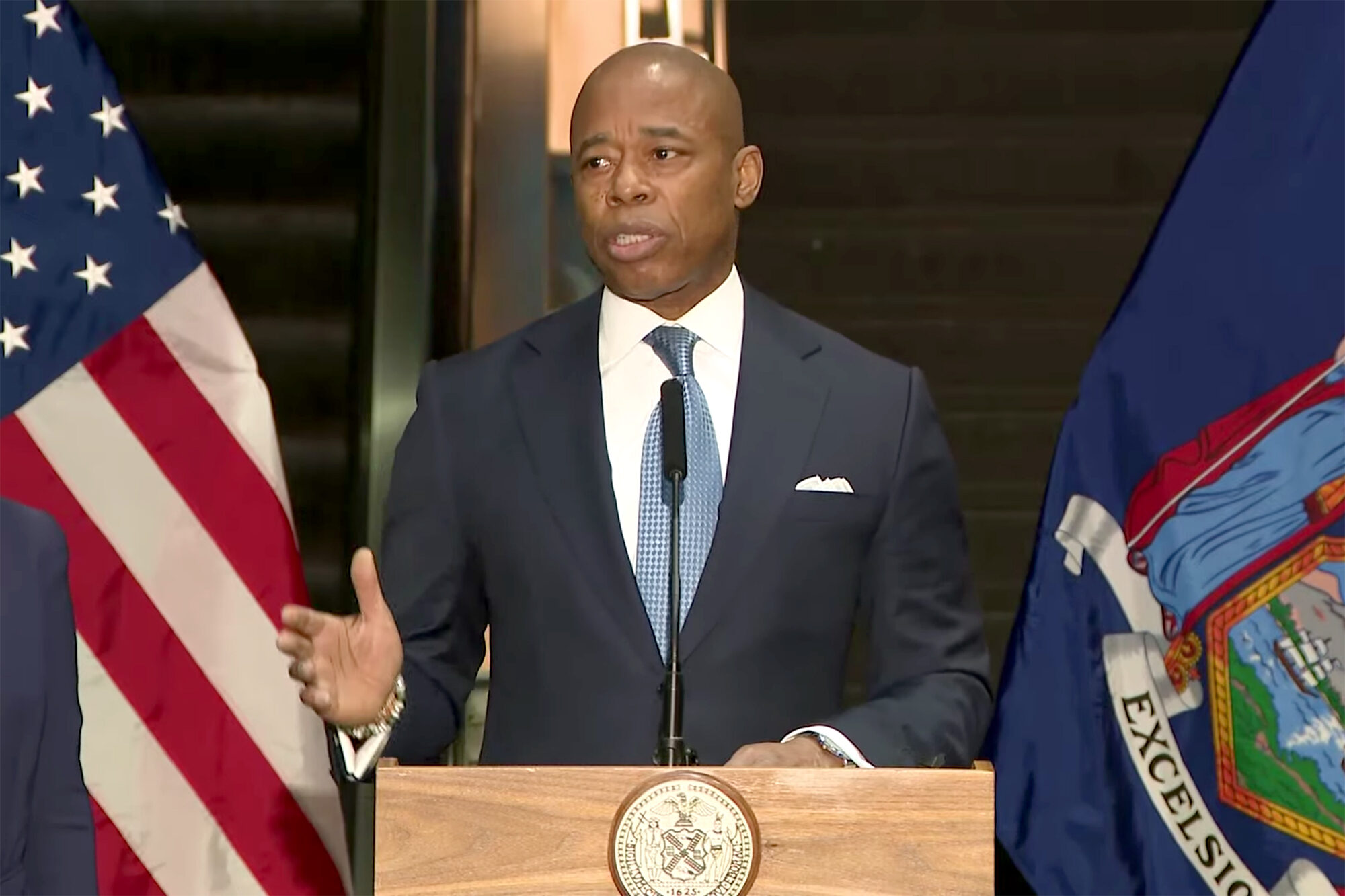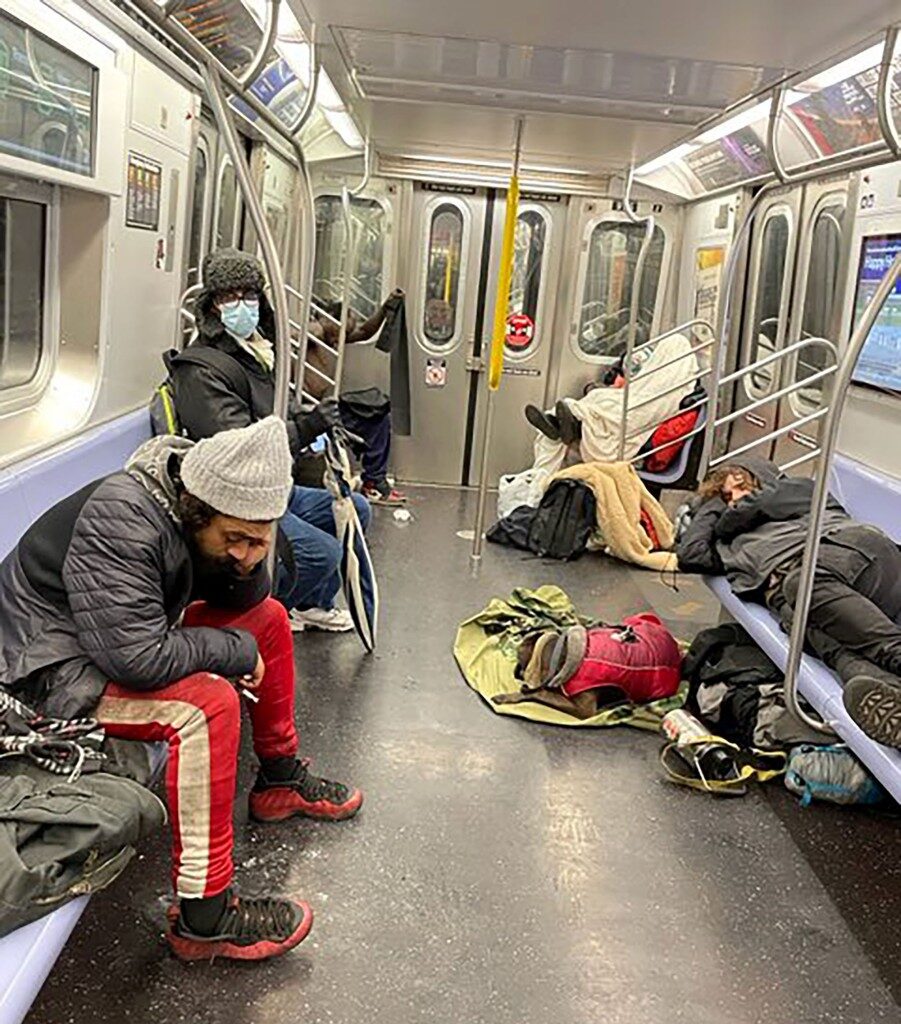
"No more smoking. No more doing drugs. No more sleeping. No more doing barbecues on the subway system. No more just doing whatever you want," he said.
"No. Those days are over. Swipe your MetroCard. Ride the system. Get off at your destination. That's what this administration is saying."
During a news conference at Manhattan's busy Fulton Street Transit Center, Adams said teams of outreach workers and NYPD cops would start canvassing the subways next week to identify mentally ill and homeless people who need to be removed and will work to get them the treatment and housing they need.
"We know where they are. There's one case where a woman has been living under a staircase for months. It's just not acceptable," he said.
"That's disgusting and that's not who we are as a city."
Adams also said that although the "vast majority" of homeless people are not dangerous, "we have to be honest about the numbers who are a danger to themselves and others."
The mayor cited an incident Thursday on an L train in Manhattan, where a 22-year-old man was stabbed while breakdancing by an assailant who's believed to be homeless.
Adams, a former NYPD captain, also noted that it took place on "a train I rode as a transit officer."
Police Commissioner Keechant Sewell said the teams "will canvass high-priority areas on the trains, inside stations and at the end of certain lines, beginning with the A, E 1, 2, N and R lines."
"We are targeting our efforts at stations and on subway lines that have seen an increasing number of riders, reports of crime, or both," she said.
"The goal, of course, is always to deter or prevent crime. Not just respond to it."
Sewell left the news conference before a Q&A session with reporters began and it's unclear when the teams will operate, how many city employees will be involved and how much the effort will cost.
A 17-page booklet outlining the program says that 30 "Joint Response Teams" would be composed of cops and workers from the Department of Homeless Services, the Department of Health and Mental Hygiene and various "community-based providers."
On Wednesday, The Post exclusively revealed that City Hall sent out a Feb. 8 email seeking to enlist DOH public school nurses, psychologists and social workers for the teams.
Adams said his plan would involve the increased application of Kendra's Law, a 1999 statute that allows judges to order outpatient treatment for mentally ill people.
It's named after Kendra Webdale, who was fatally shoved into the path of an oncoming subway earlier that year by a man with a lengthy psychiatric history.
More recently, Michelle Go, 40, was killed when a homeless man with a history of mental illness pushed her beneath an R train as it pulled into the Times Square station around 9:40 a.m. on Jan. 15.
Adams outraged New Yorkers by insisting they were safe underground — and only experiencing "the perception of fear" — before walking back those controversial comments by admitting that even he didn't feel safe "when I take the train."
Comment: This lack of insight doesn't reflect well on someone who is in a position of such influence.
Adams insisted Friday that his plan was "not about arresting people" but instead "about arresting a problem."
"We're not going to be heavy-handed," he said.
"We're not saying if you commit an infraction, we're going to put handcuffs on you. We want to correct the condition."
Adams also touted his plan as "a comprehensive civic strategy that will do more than deal with a temporary fix" to the homelessness problem.
Comment: Again this just shows how oblivious Adams is as to the systemic problems that the US is facing. With entire cities branded 'sh*tholes' because of soaring poverty, a surge in petty theft as well as violent crime, thanks in part to policies motivated by warped Woke ideology, it's highly likely that this campaign will amount to little more than a temporary fix.
"You can't put a Band-Aid on a cancerous sore. That is not how you solve the problem," he said.
"You must remove the cancer and start the healing process."
Comment: It's rather telling and disturbing that he compares the homeless problem to cancer. Historically, extreme rhetoric such as this has been used by leaders responsible for crimes against humanity.
Those remarks came under fire from the nonprofit Coalition for the Homeless Advocacy group, which said, "It is sickening to hear Mayor Adams liken unsheltered homeless people to a cancer."
"They are human beings," Shelly Nortz, the group's deputy executive director for policy, said in a prepared statement.
"The Mayor's own police department recently noted that those who shelter in the transit system are there because they believe they have no safer alternative."
Nortz also accused Adams of "repeating the failed outreach-based policing strategies of the past" and urged "great caution with respect to any regulatory or statutory expansion of involuntary commitment or outpatient treatment standards, including Kendra's Law."
Comment: Indeed. As we've seen with governments and their use of the 'temporary emergency powers' that continue after the 20
+ months of lockdowns, these changes to legislation changes are often a slippery slope into ever deeper states of pathocracy: Political Ponerology And The Rise Of Totalitarianism In The West
"Expansion of the legal criteria will not solve the problem and could result in pushing people in need further away from care," Nortz said.
"The claims that these court orders radically 'reduce' homelessness are patently false and should never be used to justify expansion of a law that is applied far more frequently to people of color than others."
City Council Speaker Adrienne Adams (D-Queen) said in a statement that "some elements" of Adams' plan — including increased health care services and new "drop-in centers" for homeless people near subway stations — "seem positive."
But she appeared willing to let the problem in stations and on trains fester, saying, "When it comes to ramping up NYPD enforcement of MTA rules of conduct to force people out of the subway system, we need to be very careful that those efforts aren't counterproductive by criminalizing people who are in need of housing or treatment."




only the phrase "IN GOD WE TRUST " shown on the banknotes, says it all to which DEMON-CRATIA , they refer to